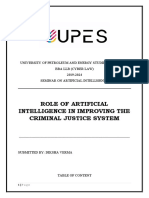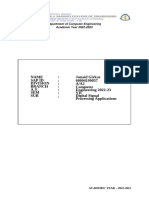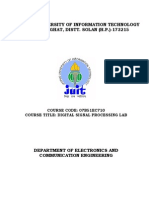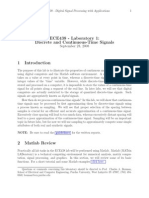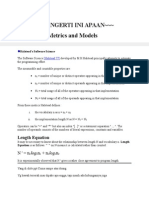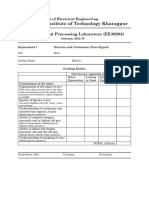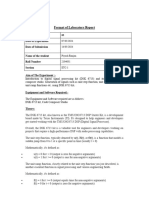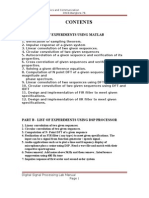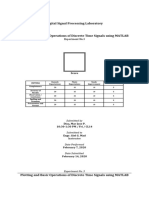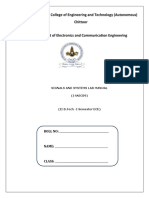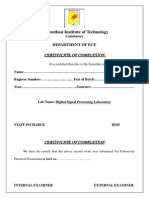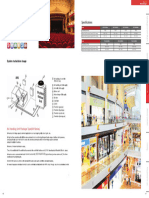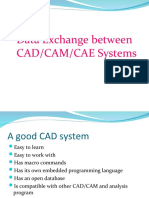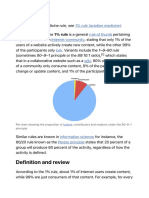DSP File
DSP File
Uploaded by
Rishabh MalhotraCopyright:
Available Formats
DSP File
DSP File
Uploaded by
Rishabh MalhotraOriginal Title
Copyright
Available Formats
Share this document
Did you find this document useful?
Is this content inappropriate?
Copyright:
Available Formats
DSP File
DSP File
Uploaded by
Rishabh MalhotraCopyright:
Available Formats
SARDAR BEANT SINGH STATE UNIVERSITY GURDASPUR
DEPARTMENT OF ELECTRONICS AND COMMUNICATION ENGINEERING
Rajinder Kumar(21305006) BTEC-21506 Digital Signal Processing Lab
5th Semester (2021 Batch) July-Dec 2023
SARDAR BEANT SINGH STATE UNIVERSITY GURDASPUR
DEPARTMENT OF ELECTRONICS AND COMMUNICATION ENGINEERING
Rajinder Kumar(21305006) BTEC-21506 Digital Signal Processing Lab
5th Semester (2021 Batch) July-Dec 2023
SARDAR BEANT SINGH STATE UNIVERSITY GURDASPUR
DEPARTMENT OF ELECTRONICS AND COMMUNICATION ENGINEERING
Rajinder Kumar(21305006) BTEC-21506 Digital Signal Processing Lab
5th Semester (2021 Batch) July-Dec 2023
SARDAR BEANT SINGH STATE UNIVERSITY GURDASPUR
DEPARTMENT OF ELECTRONICS AND COMMUNICATION ENGINEERING
Rajinder Kumar(21305006) BTEC-21506 Digital Signal Processing Lab
5th Semester (2021 Batch) July-Dec 2023
SARDAR BEANT SINGH STATE UNIVERSITY GURDASPUR
DEPARTMENT OF ELECTRONICS AND COMMUNICATION ENGINEERING
Rajinder Kumar(21305006) BTEC-21506 Digital Signal Processing Lab
5th Semester (2021 Batch) July-Dec 2023
SARDAR BEANT SINGH STATE UNIVERSITY GURDASPUR
DEPARTMENT OF ELECTRONICS AND COMMUNICATION ENGINEERING
Rajinder Kumar(21305006) BTEC-21506 Digital Signal Processing Lab
5th Semester (2021 Batch) July-Dec 2023
SARDAR BEANT SINGH STATE UNIVERSITY GURDASPUR
DEPARTMENT OF ELECTRONICS AND COMMUNICATION ENGINEERING
Rajinder Kumar(21305006) BTEC-21506 Digital Signal Processing Lab
5th Semester (2021 Batch) July-Dec 2023
SARDAR BEANT SINGH STATE UNIVERSITY GURDASPUR
DEPARTMENT OF ELECTRONICS AND COMMUNICATION ENGINEERING
Rajinder Kumar(21305006) BTEC-21506 Digital Signal Processing Lab
5th Semester (2021 Batch) July-Dec 2023
SARDAR BEANT SINGH STATE UNIVERSITY GURDASPUR
DEPARTMENT OF ELECTRONICS AND COMMUNICATION ENGINEERING
Rajinder Kumar(21305006) BTEC-21506 Digital Signal Processing Lab
5th Semester (2021 Batch) July-Dec 2023
SARDAR BEANT SINGH STATE UNIVERSITY GURDASPUR
DEPARTMENT OF ELECTRONICS AND COMMUNICATION ENGINEERING
Experiment No.- 2
Aim: To develop a program to generate a unit step function.
Apparatus: MATLAB software
Theory:
The step signal or step function is that type of standard signal which exists only for positive time
and it is zero for negative time. In other words, a signal x(t) is said to be step signal if and only if
exists for t > 0 and zero for t < 0. If a step signal has unity magnitude, then it is known as unit step
signal or unit step function. It is denoted by u(t).
Mathematically it is represented as,
{
U (t )= 1 , t ≥ 0
0 ,∧t <0
Procedure:
1. The program is entered in the MATLAB Editor and is saved with the *.m
extension.
2. The program is executed in the Command Window/editor window.
3. If any error is reported then debug it and again execute it from Command
Window/Editor Window.
4. Input if required is entered from the command Window.
5. The result is displayed in the command window.
Program:
t = -20 : 0.001 : 20;
y = heaviside(t);
plot(t, y, ‘Linewidth’, 3)
axis([-10 10 -2 2])
xlabel(‘t’)
ylabel(‘u(t)’)
title(‘Plot of Unit Step Function’)
Rajinder Kumar(21305006) BTEC-21506 Digital Signal Processing Lab
5th Semester (2021 Batch) July-Dec 2023
SARDAR BEANT SINGH STATE UNIVERSITY GURDASPUR
DEPARTMENT OF ELECTRONICS AND COMMUNICATION ENGINEERING
Experiment No.- 2
Aim: To develop a program to generate a unit step function.
Apparatus: MATLAB software
Representation:
Rajinder Kumar(21305006) BTEC-21506 Digital Signal Processing Lab
5th Semester (2021 Batch) July-Dec 2023
SARDAR BEANT SINGH STATE UNIVERSITY GURDASPUR
DEPARTMENT OF ELECTRONICS AND COMMUNICATION ENGINEERING
Experiment No.- 3
Aim: To develop a program to generate a unit step sequence.
Apparatus: MATLAB software
Theory:
The step sequence is that type of standard signal which exists only for positive discrete instants
and it is zero for negative discrete instants. In other words, a sequence u(n) is said to be step
sequence if and only if exists for n ≥ 0 and zero for n < 0. If a step sequence has unity magnitude,
then it is known as unit step sequence. It is denoted by u(n).
Mathematically it is represented as,
{
U ( n)= 1 ,n ≥ 0
0 ,∧n< 0
Procedure:
1. The program is entered in the MATLAB Editor and is saved with the *.m
extension.
2. The program is executed in the Command Window/editor window.
3. If any error is reported then debug it and again execute it from Command
Window/Editor Window.
4. Input if required is entered from the command Window.
5. The result is displayed in the command window.
Program:
n = -10 : 20;
s = [ zeros(1,10) ones(1,21)];
stem(n, s);
xlabel(‘n’);
ylabel(‘u(n)’);
title(‘Representation of Unit Step Sequence’);
axis([-10 20 0 1.2]);
Rajinder Kumar(21305006) BTEC-21506 Digital Signal Processing Lab
5th Semester (2021 Batch) July-Dec 2023
SARDAR BEANT SINGH STATE UNIVERSITY GURDASPUR
DEPARTMENT OF ELECTRONICS AND COMMUNICATION ENGINEERING
Experiment No.- 3
Aim: To develop a program to generate a unit step sequence.
Apparatus: MATLAB software
Representation:
Rajinder Kumar(21305006) BTEC-21506 Digital Signal Processing Lab
5th Semester (2021 Batch) July-Dec 2023
SARDAR BEANT SINGH STATE UNIVERSITY GURDASPUR
DEPARTMENT OF ELECTRONICS AND COMMUNICATION ENGINEERING
Experiment No.- 4
Aim: To develop a program for discrete time Unit Ramp signal.
Apparatus: MATLAB software
Theory:
The discrete time unit ramp signal is that function which starts from n = 0 and increases
linearly. It is denoted by r(n). It is signal whose amplitude varies linearly with time n.
Mathematically, the discrete time unit ramp sequence is defined as-
{
r ( n ) = n ,∧for n ≥0
0 ,∧for n< 0
also r ( n ) =n∗u (n)
Procedure:
1. The program is entered in the MATLAB Editor and is saved with the *.m
extension.
2. The program is executed in the Command Window/editor window.
3. If any error is reported then debug it and again execute it from Command
Window/Editor Window.
4. Input if required is entered from the command Window.
5. The result is displayed in the command window.
Program:
Method I: Method II:
n = 0:20;
n = -10:1:10;
y = n;
z = (n>=0).*n; stem(n,y)
xlabel(“n”);
stem(n,z)
ylabel(“Amplitude”);
xlabel(“n”);
title(“Unit Ramp Sequence”);
ylabel(“Amplitude”);
Rajinder Kumar(21305006) BTEC-21506 Digital Signal Processing Lab
5th Semester (2021 Batch) July-Dec 2023
SARDAR BEANT SINGH STATE UNIVERSITY GURDASPUR
DEPARTMENT OF ELECTRONICS AND COMMUNICATION ENGINEERING
title(“Unit Ramp Sequence”);
Experiment No.- 5
Aim: To develop a program for discrete time Unit Impulse signal.
Apparatus: MATLAB software
Theory:
The discrete time unit impulse sequence δ (n), also called the unit Sample sequence, is
defined as,
{
δ ( n )= 1 , for n=0
¿ 0 , for n≠ 0
Procedure:
1. The program is entered in the MATLAB Editor and is saved with the *.m
extension.
2. The program is executed in the Command Window/editor window.
3. If any error is reported then debug it and again execute it from Command
Window/Editor Window.
4. Input if required is entered from the command Window.
5. The result is displayed in the command window.
Program:
n = -20:20;
delta_n = [zeros(1,20) 1 zeros(1,20)]
stem(n,delta_n)
xlabel(“n”);
ylabel(“Amplitude”);
title(“Unit Impulse Signal);
Rajinder Kumar(21305006) BTEC-21506 Digital Signal Processing Lab
5th Semester (2021 Batch) July-Dec 2023
SARDAR BEANT SINGH STATE UNIVERSITY GURDASPUR
DEPARTMENT OF ELECTRONICS AND COMMUNICATION ENGINEERING
Experiment No.- 6
Aim: To develop a program to add two sequences.
Apparatus: MATLAB software
Theory:
In MATLAB we can add or subtract discrete time signals to study them.
Procedure:
1. The program is entered in the MATLAB Editor and is saved with the *.m
extension.
2. The program is executed in the Command Window/editor window.
3. If any error is reported then debug it and again execute it from Command
Window/Editor Window.
4. Input if required is entered from the command Window.
5. The result is displayed in the command window.
Program:
sequence1 = [1, 2, 3, 4, 5];
sequence2 = [6, 7, 8, 9, 10];
if length(sequence1) ~= length(sequence2)
error('Sequences must have the same length');
end
result = sequence1 + sequence2;
figure;
subplot(3, 1, 1);
Rajinder Kumar(21305006) BTEC-21506 Digital Signal Processing Lab
5th Semester (2021 Batch) July-Dec 2023
SARDAR BEANT SINGH STATE UNIVERSITY GURDASPUR
DEPARTMENT OF ELECTRONICS AND COMMUNICATION ENGINEERING
stem(sequence1, 'filled', 'LineWidth', 2);
title('Sequence 1');
xlabel('Index');
ylabel('Value');
subplot(3, 1, 2);
stem(sequence2, 'filled', 'LineWidth', 2);
title('Sequence 2');
xlabel('Index');
ylabel('Value');
subplot(3, 1, 3);
stem(result, 'filled', 'LineWidth', 2);
title('Result');
xlabel('Index');
ylabel('Value');
Representation:
Rajinder Kumar(21305006) BTEC-21506 Digital Signal Processing Lab
5th Semester (2021 Batch) July-Dec 2023
SARDAR BEANT SINGH STATE UNIVERSITY GURDASPUR
DEPARTMENT OF ELECTRONICS AND COMMUNICATION ENGINEERING
Experiment No.- 7
Aim: To develop program for computing Z-transform.
Apparatus: MATLAB software
Theory:
In mathematics and signal processing, the Z-transform converts a discrete-time signal,
which is a sequence of real and complex numbers, into a complex frequency-domain
representation.
The Z-transform of a discrete-time signal x(n) is defined by
∞
X (Z )= ∑ x(n)z−n
n=−∞
Where z = rejw is a complex variable. The value of z for which the sum converges define a region
in the Z-plane referred to as the region of convergence(ROC).
Procedure:
Rajinder Kumar(21305006) BTEC-21506 Digital Signal Processing Lab
5th Semester (2021 Batch) July-Dec 2023
SARDAR BEANT SINGH STATE UNIVERSITY GURDASPUR
DEPARTMENT OF ELECTRONICS AND COMMUNICATION ENGINEERING
1. The program is entered in the MATLAB Editor and is saved with the *.m
extension.
2. The program is executed in the Command Window/editor window.
3. If any error is reported then debug it and again execute it from Command
Window/Editor Window.
4. Input if required is entered from the command Window.
5. The result is displayed in the command window.
Program:
Method-I (Using for loop) Method-II (Using Z-transform function)
X = [1 2 3 4 5]; syms n
L = length(x); f = sin(n);
Z = sym(‘Z’);s r = ztrans(f);
for i = 0:L-1 disp(‘Z-transform using function’);
X = X + X(i+1)*Z-i; disp(r);
end
disp(‘displaying output’);
disp(X);
Representation:
By using both Method-I and Method-II.
Rajinder Kumar(21305006) BTEC-21506 Digital Signal Processing Lab
5th Semester (2021 Batch) July-Dec 2023
SARDAR BEANT SINGH STATE UNIVERSITY GURDASPUR
DEPARTMENT OF ELECTRONICS AND COMMUNICATION ENGINEERING
Experiment No.- 8
Aim: To develop program for computing inverse Z-transform.
Apparatus: MATLAB software
Theory:
Rajinder Kumar(21305006) BTEC-21506 Digital Signal Processing Lab
5th Semester (2021 Batch) July-Dec 2023
SARDAR BEANT SINGH STATE UNIVERSITY GURDASPUR
DEPARTMENT OF ELECTRONICS AND COMMUNICATION ENGINEERING
The inverse Z-transform is defined as the process of finding the time domain signal x(n)
from its Z-transform X(z). Then inverse Z-transform is denoted as-
−n
x ( n )=Z [ X ( z )]
Where, z is a complex variable and is given by, Z = rejw
Procedure:
1. The program is entered in the MATLAB Editor and is saved with the *.m
extension.
2. The program is executed in the Command Window/editor window.
3. If any error is reported then debug it and again execute it from Command
Window/Editor Window.
4. Input if required is entered from the command Window.
5. The result is displayed in the command window.
Program:
syms n
f = sin(n);
z = ztrans(f);
disp(‘ztransform of sin(n) is’);
disp(z);
zz = iztrans(z);
disp(‘displaying inverse z transform);
disp(zz);
Representation:
Rajinder Kumar(21305006) BTEC-21506 Digital Signal Processing Lab
5th Semester (2021 Batch) July-Dec 2023
SARDAR BEANT SINGH STATE UNIVERSITY GURDASPUR
DEPARTMENT OF ELECTRONICS AND COMMUNICATION ENGINEERING
Experiment No.- 9
Aim: Write a program in MATLAB to verify linear convolution.
Apparatus: MATLAB software
Rajinder Kumar(21305006) BTEC-21506 Digital Signal Processing Lab
5th Semester (2021 Batch) July-Dec 2023
SARDAR BEANT SINGH STATE UNIVERSITY GURDASPUR
DEPARTMENT OF ELECTRONICS AND COMMUNICATION ENGINEERING
Theory:
In case of convolution two signal sequences input signal x(n) and impulse response h(n)
given by the same system, output y(n) is calculated by multiplication of two sequences in time
domain is called as Linear Convolution.
Linear Convolution is given by the equation
y(n) = x(n)*h(n)
and calculated as,
∞
❑
y (n) = ∑ ❑
x ( k ) h(n−k )
k =−∞
Procedure:
1. The program is entered in the MATLAB Editor and is saved with the *.m
extension.
2. The program is executed in the Command Window/editor window.
3. If any error is reported then debug it and again execute it from Command
Window/Editor Window.
4. Input if required is entered from the command Window.
5. The result is displayed in the command window.
Program:
x1 = [1 2 3 4];
x2 = [2 4 3 1 5 6 8];
y = conv(x1,x2);
subplot(311)
stem(‘x1’)
xlabel(‘n’);
ylabel(‘x1[n]’);
title(‘vector x1’)
subplot(312)
stem(‘x2’)
xlabel(‘n’);
Rajinder Kumar(21305006) BTEC-21506 Digital Signal Processing Lab
5th Semester (2021 Batch) July-Dec 2023
SARDAR BEANT SINGH STATE UNIVERSITY GURDASPUR
DEPARTMENT OF ELECTRONICS AND COMMUNICATION ENGINEERING
ylabel(‘x2[n]’);
title(‘vector x2’)
subplot(313)
stem(‘y’)
xlabel(‘n’);
ylabel(‘y[n]’);
title(‘Linear convolution’)
Representation:
Experiment No.- 10
Aim: To develop program for computing DFT and IDFT.
Apparatus: MATLAB software
Rajinder Kumar(21305006) BTEC-21506 Digital Signal Processing Lab
5th Semester (2021 Batch) July-Dec 2023
SARDAR BEANT SINGH STATE UNIVERSITY GURDASPUR
DEPARTMENT OF ELECTRONICS AND COMMUNICATION ENGINEERING
Theory:
DFT- The N-point DFT of a finite duration sequence of length L, where N≥L is defined
as,
DFT ¿ ;k=0,1,2,…..,N-1
IDFT- The Inverse Discrete Fourier Transform of sequence X(k) of length N is defined
as:
N−1 j2πnk
1
IDFT [ X ( K ) ] =x ( n )=
N
∑ X (k )e N
; n= 0,1,2,….,N-1
k=0
Procedure:
1. The program is entered in the MATLAB Editor and is saved with the *.m
extension.
2. The program is executed in the Command Window/editor window.
3. If any error is reported then debug it and again execute it from Command
Window/Editor Window.
4. Input if required is entered from the command Window.
5. The result is displayed in the command window.
Program:
xn = input(‘Enter the input sequence’)
n = length(xn)
n =0:1:N-1;
subplot(2,2,1)
stem(n,xn)
xlabel(‘time’)
ylabel(‘amplitude’)
title(‘Input sequence’)
xk = fft(xn,N)
disp(kx)
k=0:1:N-1;
subplot(2,2,2)
Rajinder Kumar(21305006) BTEC-21506 Digital Signal Processing Lab
5th Semester (2021 Batch) July-Dec 2023
SARDAR BEANT SINGH STATE UNIVERSITY GURDASPUR
DEPARTMENT OF ELECTRONICS AND COMMUNICATION ENGINEERING
stem(k,xk)
xlabel(‘time’)
ylabel(‘amplitude’)
title(‘DFT’)
X=ifft(xk,N)
disp(X)
n=0:1:N-1;
subplot(2,2,3)
stem(n,x)
xlabel(‘time’)
ylabel(‘amplitude’)
title(‘IDFT’)
Representation: For input sequence xn =[1 2 3 4 5], thus N=5
Rajinder Kumar(21305006) BTEC-21506 Digital Signal Processing Lab
5th Semester (2021 Batch) July-Dec 2023
You might also like
- Role of AI in Improving The Criminal Justice SystemDocument15 pagesRole of AI in Improving The Criminal Justice Systemdiksha vermaNo ratings yet
- (Doc Watson) My Grandfathers Clock Acoustic TABDocument4 pages(Doc Watson) My Grandfathers Clock Acoustic TABmiromarkoNo ratings yet
- Updated DSP Manual 15ECL57 PDFDocument97 pagesUpdated DSP Manual 15ECL57 PDFanujna100% (1)
- JunaidGirkar DSPA Experiments 1-9Document47 pagesJunaidGirkar DSPA Experiments 1-9bhuvaneducationpurposeNo ratings yet
- Lab Manual EC DSP 3171003Document61 pagesLab Manual EC DSP 3171003kundanscithNo ratings yet
- DSP Lab MaualDocument53 pagesDSP Lab MaualAllanki Sanyasi RaoNo ratings yet
- SS Lab ManualDocument48 pagesSS Lab ManualKannan RNo ratings yet
- DSP LabSheet Exp-1,2 ,3 (1)Document15 pagesDSP LabSheet Exp-1,2 ,3 (1)Arnab ChowdhuryNo ratings yet
- SS Lab 4Document5 pagesSS Lab 4monishdas988No ratings yet
- DSP Lab Manual JuitDocument13 pagesDSP Lab Manual JuitaankuragrawalNo ratings yet
- EE Lab Manuls Fast NuDocument70 pagesEE Lab Manuls Fast NuMuhammad SaadNo ratings yet
- Practical File: Digital Signal ProcessingDocument30 pagesPractical File: Digital Signal Processingmkumar3925No ratings yet
- SP Manual 2023-24Document98 pagesSP Manual 2023-24Manjunath ReddyNo ratings yet
- Itc ProjectDocument8 pagesItc ProjectOutLaw LuciferNo ratings yet
- DSP Lab Manual 2016Document113 pagesDSP Lab Manual 2016Gangadharareddy PeddamalluNo ratings yet
- DSP Lab Manual Updated - August2018Document80 pagesDSP Lab Manual Updated - August2018Qasim LodhiNo ratings yet
- DSP Lab ManualDocument22 pagesDSP Lab ManualAishwarya GNo ratings yet
- DSP 5Document5 pagesDSP 5kashyap.piyush2003No ratings yet
- Process Control Laboratory Exercise No. 5 PID Controller Using Matlab 1. ObjectiveDocument13 pagesProcess Control Laboratory Exercise No. 5 PID Controller Using Matlab 1. ObjectiveNelykah Rianne MartijaNo ratings yet
- DSP LAB ManualDocument44 pagesDSP LAB Manualnarendra kumarNo ratings yet
- DSP Lab Manual: 5 Semester Electronics and Communication Subject Code: 18ecl57 2020-21Document58 pagesDSP Lab Manual: 5 Semester Electronics and Communication Subject Code: 18ecl57 2020-21Axis AlexNo ratings yet
- LAB-2-1Document12 pagesLAB-2-1fa21-bee-030No ratings yet
- Lab 1 - Introduction To MATLAB 2023 - 24Document17 pagesLab 1 - Introduction To MATLAB 2023 - 24nurulfarahanis.mnNo ratings yet
- Lab1 1Document10 pagesLab1 1Bogdan LupeNo ratings yet
- LOKESH - DSP Practical File (251901018 ECE A)Document25 pagesLOKESH - DSP Practical File (251901018 ECE A)wiwaNo ratings yet
- DSP Lab Manual Upto 3 Cycles PDFDocument45 pagesDSP Lab Manual Upto 3 Cycles PDFDinesh PalavalasaNo ratings yet
- Ali DSP Lab4Report.Document17 pagesAli DSP Lab4Report.Muhammad AliNo ratings yet
- Studying Digital Signal Processing On Arduino Based PlatformDocument6 pagesStudying Digital Signal Processing On Arduino Based Platformstephen562001No ratings yet
- Soft Computing Lab ManualDocument13 pagesSoft Computing Lab ManualSwarnim ShuklaNo ratings yet
- Satcom 210280111015Document14 pagesSatcom 210280111015Siddharth DoshiNo ratings yet
- DSP Lab ManualDocument32 pagesDSP Lab ManualPRAFFULL JAINNo ratings yet
- SPlabDocument34 pagesSPlabLRani LoganathanNo ratings yet
- Gue Kaga Ngerti Ini ApaanDocument5 pagesGue Kaga Ngerti Ini ApaancyntiaNo ratings yet
- Ninevah University College of Electronics Engineering Systems & Control Engineering Department SCE3201 Digital Signal Processing-I LabDocument5 pagesNinevah University College of Electronics Engineering Systems & Control Engineering Department SCE3201 Digital Signal Processing-I LabMamounNo ratings yet
- Soft Lab - Iii Ec506Document34 pagesSoft Lab - Iii Ec506Akanksha DixitNo ratings yet
- Format of Laboratory ReportDocument4 pagesFormat of Laboratory Reportkashyap.piyush2003No ratings yet
- EE39203 Aut2022 Exp1Document5 pagesEE39203 Aut2022 Exp1Arul AnandanNo ratings yet
- Digital Signal Processing Lab Manual Using MatlabDocument33 pagesDigital Signal Processing Lab Manual Using MatlabrpecglobalNo ratings yet
- DSP Lab Record Exp-1Document19 pagesDSP Lab Record Exp-1Prabhu ChNo ratings yet
- Daa 2 ZoroDocument3 pagesDaa 2 Zorosaksham MehtaNo ratings yet
- DSP Lab Manual For ECE 3 2 R09Document147 pagesDSP Lab Manual For ECE 3 2 R09Jandfor Tansfg Errott100% (2)
- DSP Lab Manual PDFDocument51 pagesDSP Lab Manual PDFashok1683100% (1)
- S&s Lab ManualDocument93 pagesS&s Lab Manualtauseef124No ratings yet
- Lab Manual DSP1Document32 pagesLab Manual DSP1OmkarNo ratings yet
- Abhishek Goyal (DSP LAB PRACTICAL File)Document33 pagesAbhishek Goyal (DSP LAB PRACTICAL File)Manthan SinghNo ratings yet
- AmmmathalliDocument83 pagesAmmmathalliThota sivasriNo ratings yet
- Sri Venkateswara College of Engineering and TechnologyDocument47 pagesSri Venkateswara College of Engineering and TechnologyKannan RNo ratings yet
- DSP Lab 5-2104031Document4 pagesDSP Lab 5-2104031kashyap.piyush2003No ratings yet
- Digital Signal Processing ManualDocument106 pagesDigital Signal Processing Manual64emily64100% (1)
- Record PgmsDocument48 pagesRecord Pgmsgojothehonouredone99No ratings yet
- Digital Signal Processing Laboratory: Experiment No.3Document15 pagesDigital Signal Processing Laboratory: Experiment No.3Mark Anthony RazonNo ratings yet
- DSP Lab Manual 2022 23Document108 pagesDSP Lab Manual 2022 23sagar kothawarNo ratings yet
- Lab ManualDocument56 pagesLab ManualmohanNo ratings yet
- SslabDocument42 pagesSslabparantnNo ratings yet
- SIGNALS-SYSTEMS LAB ManualDocument44 pagesSIGNALS-SYSTEMS LAB Manualmahendra161024No ratings yet
- PDF File For Oled Full ReportDocument31 pagesPDF File For Oled Full ReportAakash AggarwalNo ratings yet
- DSP Record For Ece HitDocument66 pagesDSP Record For Ece Hithakkem bNo ratings yet
- Computer Project-2Document129 pagesComputer Project-2sakshamraj12aprNo ratings yet
- Ninevah University College of Electronics Engineering Systems & Control Engineering Department SCE3201 Digital Signal Processing-I LabDocument5 pagesNinevah University College of Electronics Engineering Systems & Control Engineering Department SCE3201 Digital Signal Processing-I LabMamounNo ratings yet
- DSP Lab ManualDocument41 pagesDSP Lab ManualMaha GeorgeNo ratings yet
- Program/ Demo Execution Viva-Voce Record Total 10 30 30 10 10 10 100Document3 pagesProgram/ Demo Execution Viva-Voce Record Total 10 30 30 10 10 10 100Sathiya MurthiNo ratings yet
- ANS Tute 1-3Document9 pagesANS Tute 1-3Rishabh MalhotraNo ratings yet
- Wepik Exploring Chord Properties Unveiling The Intricacies of CirclesDocument10 pagesWepik Exploring Chord Properties Unveiling The Intricacies of CirclesRishabh MalhotraNo ratings yet
- Revised Syllabus Scheme 2023 Merged First YearDocument34 pagesRevised Syllabus Scheme 2023 Merged First YearRishabh MalhotraNo ratings yet
- DocScanner Nov 24, 2023 21-04Document1 pageDocScanner Nov 24, 2023 21-04Rishabh MalhotraNo ratings yet
- EPM Unit-IVDocument26 pagesEPM Unit-IVRishabh MalhotraNo ratings yet
- Ahu KitDocument1 pageAhu Kitkarun agrawalNo ratings yet
- Alloy Wheel Process Audit 28.11.23 - Google SheetsDocument1 pageAlloy Wheel Process Audit 28.11.23 - Google Sheetsmunireddy.vNo ratings yet
- 7 Tools of Statistical Process ControlDocument3 pages7 Tools of Statistical Process ControlSachin Methree100% (1)
- Brief SCMPE M23Document69 pagesBrief SCMPE M23Kush ShahNo ratings yet
- Pengaruh Model Pembelajaran Inkuiri Terbimbing Dan Minat Belajar Terhadap Keterampilan Proses Sains Pada Siswa Kelas Iv SDDocument9 pagesPengaruh Model Pembelajaran Inkuiri Terbimbing Dan Minat Belajar Terhadap Keterampilan Proses Sains Pada Siswa Kelas Iv SDJosefin Desiana SitungkirNo ratings yet
- CSA B52-13 - Safety Bulletin - Maximum Refrigerant Quantities Per Occupied SpaceDocument7 pagesCSA B52-13 - Safety Bulletin - Maximum Refrigerant Quantities Per Occupied SpaceJean-Francois GourdeNo ratings yet
- Chapter1 IaasDocument2 pagesChapter1 IaasRAYNALD A. PAYATNo ratings yet
- FP Engineered and Specialty Transformer CatalogDocument40 pagesFP Engineered and Specialty Transformer CatalogBENSON MAKWABANo ratings yet
- SURA'S 7th STD 5 in 1 Term 3 TM Sample Study MaterialsDocument111 pagesSURA'S 7th STD 5 in 1 Term 3 TM Sample Study MaterialssanjayNo ratings yet
- W1 Microprocessor Introduction Module 1Document6 pagesW1 Microprocessor Introduction Module 1Aaron BasNo ratings yet
- Assemly Language 02: To Pay More Attention To Gain Better ResultDocument24 pagesAssemly Language 02: To Pay More Attention To Gain Better Resulttuan luuNo ratings yet
- AON BufferDocument24 pagesAON BufferAli AliNo ratings yet
- Earthing & Equipotential BondingDocument78 pagesEarthing & Equipotential BondingafmNo ratings yet
- MH-DL Technical - Presentation ModifiedDocument27 pagesMH-DL Technical - Presentation ModifiedHikmat B. Ayer - हिक्मत ब. ऐरNo ratings yet
- Chapter 17 (Lect 48 and Micro Programmed Control Intro.)Document15 pagesChapter 17 (Lect 48 and Micro Programmed Control Intro.)nancy_01No ratings yet
- Cek List Tools MWS: No. Tools Name (Size) Q'TyDocument2 pagesCek List Tools MWS: No. Tools Name (Size) Q'TyAwal PagiNo ratings yet
- Jenkins Interview Questions: 1) Mention What Is Jenkins?Document3 pagesJenkins Interview Questions: 1) Mention What Is Jenkins?abhi gargNo ratings yet
- Data Exchange Between CAD/CAM/CAE SystemsDocument34 pagesData Exchange Between CAD/CAM/CAE SystemsHarsheel PanchasaraNo ratings yet
- Mad Lab RecordDocument95 pagesMad Lab RecordvamsiNo ratings yet
- C020100 Model LPD - C020200 Model MSD: Intended Use UnpackingDocument2 pagesC020100 Model LPD - C020200 Model MSD: Intended Use UnpackingDoris Torres CabezasNo ratings yet
- TESDA Circular No. 040-2021Document25 pagesTESDA Circular No. 040-2021marie buenaventuraNo ratings yet
- 1 Percent RuleDocument4 pages1 Percent RuleArohnesNo ratings yet
- Proop HMI Panel User ManualDocument193 pagesProop HMI Panel User ManualThai TranNo ratings yet
- Peiner Smag Machinery (India) Private LimitedDocument16 pagesPeiner Smag Machinery (India) Private LimitedRei_budNo ratings yet
- Fault Report MF HFDocument2 pagesFault Report MF HFBrian BennettNo ratings yet
- Software Design PrinciplesDocument30 pagesSoftware Design PrinciplesNandumano ManoharanNo ratings yet
- GE Logiq 7, 7pro Ultrasound - Quick User ManualDocument60 pagesGE Logiq 7, 7pro Ultrasound - Quick User ManualmagdiNo ratings yet
- MD1 Lab Templates TUP Feb2024Document4 pagesMD1 Lab Templates TUP Feb2024Lledniw GamesNo ratings yet
